Gregory A. Fournier's Blog
September 26, 2025
Docuartist DeVon Cunningham--a Detroit Art Treasure--has Left this Vale of Tears
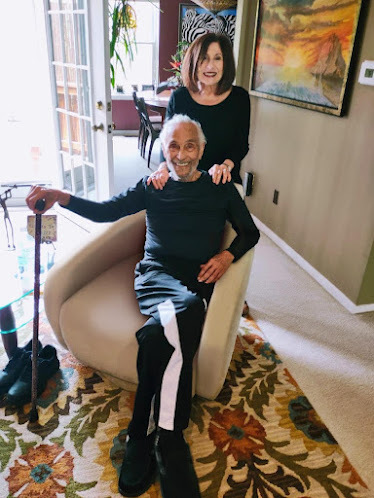 DeVon Cunningham and his loving partner Rose Johnson
DeVon Cunningham and his loving partner Rose JohnsonBorn in Tuscaloosa, Alabama on February 21, 1935, DeVon Cunningham began his art training at the tender age of eleven when he won a scholarship to the John Herron Art Institute in Indianapolis, Indiana. Part of his training was a two-week, all expenses paid seminar to study in Italy.
He continued his art training at the Detroit Center for Creative Studies and the Birmingham Bloomfield Art Center. Cunningham went on to complete a bachelor's degree from the Detroit Institute of Technology and a master's degree from Wayne State University.
While he was working as a community outreach and public relationsexecutive for Detroit Edison, DeVon was painting. Over his long career, DeVon's paintings have appeared in many galleries including eleven one-man shows, and his work hangs in many private and public art collections. His work is digitally archived and indexed in the catalog for the National Portrait Gallery of the Smithsonian Institute.
In 1969, DeVon Cunningham achieved national recognition when he painted the mural of the Black Christ on the dome of St. Cecelia Catholic church at Livernois and Burlingame in Detroit. This work featured a twenty-four-foot, brown-skinned image of Jesus with six multiethnic angels beside him serving high mass. The church's parishioners were mostly African Americans from the neighborhood. The mural was a welcomed addition to this French Romanesque church built in 1930 before the ethnicity of the neighborhood changed.
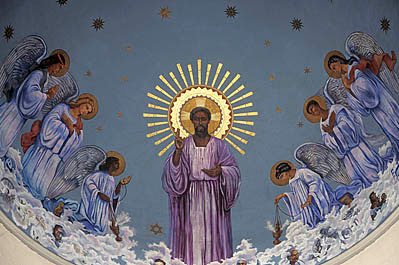
A national controversy erupted when the mural appeared on the cover of Ebony magazine in March 1969. Twenty-five years later on December 25th, 1994, the mural once again became the topic of controversy when the New York Times featured the church mural on Christmas Day. Reverend Raymond Ellis, rector of St. Cecelia's, responded to the criticism in a Detroit Free Press interview.
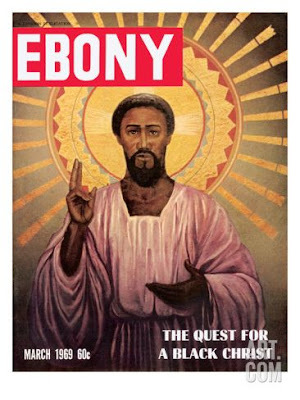 "Black parishioners have a legitmate complaint when they walk into a church to worship and everything is white. Christianity forces people to accept Western European culture.
"Black parishioners have a legitmate complaint when they walk into a church to worship and everything is white. Christianity forces people to accept Western European culture."The historical Christ was Hebrew, a Jew from the Middle East. He might have had dark skin; he might have been fair. But Christ is the head of the church, he is God, and he is any color people want him to be."
Cunningham's commissioned portraits of prominent Detroit community leaders includeMartha Jean "The Queen" Steinberg, a WCHB radio personality active in Detroit's African American community; Coleman Young, the city's first black mayor; Abe Burnstein, Detroit's reputed Purple Gang boss during Prohibition; and many others.
The most mysterious portrait Cunningham has painted is of Motown founder Berry Gordy Jr. It was unveiled at Gordy's Boston-Edison mansion as a birthday present from his sister Anna Gordy Gaye--the wife of singer Marvin Gaye. Berry was quite moved and lauded the painting of him dressed up like Napoleon. Somewhere along the line, someone suggested that it might not be a compliment to be compared to Napoleon, and the painting disappeared. (More on that story appears in the link at the end of this post.)
Cunningham's portraits gave way to what he calls docuart that informs, instructs, and involves the viewer. His work combines symbolism with cultural iconography that leaves the viewer with a montage of images to ponder. DeVon's art not only appeals to the eye but also to the mind.
DeVon's jazz musician series typifies much of his later work. Historically, Detroit was instrumental in the 1920s through the 1950s for providing African American jazz and blues musicians venues to perform and make a living through their music. To document the historic relationship of Jews and African Americans, Cunningham painted legendary performers like Theolonius Monk, Louie Armstrong, Billie Holiday, and Miles Davis, who performed in Detroit's legendary nightclubs owned by Jewish impresarios who hired Black acts when other venue bookers would not.
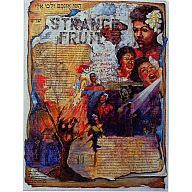 Billie Holiday docuart DeVon Cunningham has produced significant art that remains relevant in our changing times. The Spill the Honey foundation commissioned a series of paintings that emphasizes the shared legacy of Jewish people and African Americans seeking historical truth and social justice through educational and artistic programs. The theme of Cunningham's last body of work deals with the environment and the pollinators--both endangered.
Billie Holiday docuart DeVon Cunningham has produced significant art that remains relevant in our changing times. The Spill the Honey foundation commissioned a series of paintings that emphasizes the shared legacy of Jewish people and African Americans seeking historical truth and social justice through educational and artistic programs. The theme of Cunningham's last body of work deals with the environment and the pollinators--both endangered.Mr. Cunningham passed away at 1:00 am Monday morning, July 31st at the age of eighty-eight after complications from a prolonged illness. Only two weeks before, DeVon and Rose Johnson went to Cafe D'Mongo's in downtown Detroit for his last outing where he enjoyed meeting with some of his fans, my wife Sue and I among them.
Berry Gordy's Lost Portrait Martha Jean the Queen
Docuartist DeVon Cunningham--a Detroit Art Treasure--has Left this Vale of Tears Behind
 DeVon Cunningham and his loving partner Rose Johnson
DeVon Cunningham and his loving partner Rose JohnsonBorn in Tuscaloosa, Alabama on February 21, 1935, DeVon Cunningham began his art training at the tender age of eleven when he won a scholarship to the John Herron Art Institute in Indianapolis, Indiana. Part of his training was a two-week, all expenses paid seminar to study in Italy.
He continued his art training at the Detroit Center for Creative Studies and the Birmingham Bloomfield Art Center. Cunningham went on to complete a bachelor's degree from the Detroit Institute of Technology and a master's degree from Wayne State University.
While he was working as a community outreach and public relationsexecutive for Detroit Edison, DeVon was painting. Over his long career, DeVon's paintings have appeared in many galleries including eleven one-man shows, and his work hangs in many private and public art collections. His work is digitally archived and indexed in the catalog for the National Portrait Gallery of the Smithsonian Institute.
In 1969, DeVon Cunningham achieved national recognition when he painted the mural of the Black Christ on the dome of St. Cecelia Catholic church at Livernois and Burlingame in Detroit. This work featured a twenty-four-foot, brown-skinned image of Jesus with six multiethnic angels beside him serving high mass. The church's parishioners were mostly African Americans from the neighborhood. The mural was a welcomed addition to this French Romanesque church built in 1930 before the ethnicity of the neighborhood changed.

A national controversy erupted when the mural appeared on the cover of Ebony magazine in March 1969. Twenty-five years later on December 25th, 1994, the mural once again became the topic of controversy when the New York Times featured the church mural on Christmas Day. Reverend Raymond Ellis, rector of St. Cecelia's, responded to the criticism in a Detroit Free Press interview.
 "Black parishioners have a legitmate complaint when they walk into a church to worship and everything is white. Christianity forces people to accept Western European culture.
"Black parishioners have a legitmate complaint when they walk into a church to worship and everything is white. Christianity forces people to accept Western European culture."The historical Christ was Hebrew, a Jew from the Middle East. He might have had dark skin; he might have been fair. But Christ is the head of the church, he is God, and he is any color people want him to be."
Cunningham's commissioned portraits of prominent Detroit community leaders includeMartha Jean "The Queen" Steinberg, a WCHB radio personality active in Detroit's African American community; Coleman Young, the city's first black mayor; Abe Burnstein, Detroit's reputed Purple Gang boss during Prohibition; and many others.
The most mysterious portrait Cunningham has painted is of Motown founder Berry Gordy Jr. It was unveiled at Gordy's Boston-Edison mansion as a birthday present from his sister Anna Gordy Gaye--the wife of singer Marvin Gaye. Berry was quite moved and lauded the painting of him dressed up like Napoleon. Somewhere along the line, someone suggested that it might not be a compliment to be compared to Napoleon, and the painting disappeared. (More on that story appears in the link at the end of this post.)
Cunningham's portraits gave way to what he calls docuart that informs, instructs, and involves the viewer. His work combines symbolism with cultural iconography that leaves the viewer with a montage of images to ponder. DeVon's art not only appeals to the eye but also to the mind.
DeVon's jazz musician series typifies much of his later work. Historically, Detroit was instrumental in the 1920s through the 1950s for providing African American jazz and blues musicians venues to perform and make a living through their music. To document the historic relationship of Jews and African Americans, Cunningham painted legendary performers like Theolonius Monk, Louie Armstrong, Billie Holiday, and Miles Davis, who performed in Detroit's legendary nightclubs owned by Jewish impresarios who hired Black acts when other venue bookers would not.
 Billie Holiday docuart DeVon Cunningham has produced significant art that remains relevant in our changing times. The Spill the Honey foundation commissioned a series of paintings that emphasizes the shared legacy of Jewish people and African Americans seeking historical truth and social justice through educational and artistic programs. The theme of Cunningham's last body of work deals with the environment and the pollinators--both endangered.
Billie Holiday docuart DeVon Cunningham has produced significant art that remains relevant in our changing times. The Spill the Honey foundation commissioned a series of paintings that emphasizes the shared legacy of Jewish people and African Americans seeking historical truth and social justice through educational and artistic programs. The theme of Cunningham's last body of work deals with the environment and the pollinators--both endangered.Mr. Cunningham passed away at 1:00 am Monday morning, July 31st at the age of eighty-eight after complications from a prolonged illness. Only two weeks before, DeVon and Rose Johnson went to Cafe D'Mongo's in downtown Detroit for his last outing where he enjoyed meeting with some of his fans, my wife Sue and I among them.
Berry Gordy's Lost Portrait Martha Jean the Queen
September 20, 2025
Fornology Blog Reaches Two-Million Hits
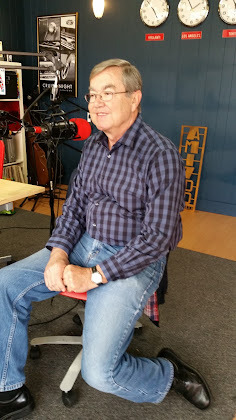 Doing a radio interview in Ypsilanti, Michigan (2016).
Doing a radio interview in Ypsilanti, Michigan (2016).I began writing my Fornology blog in April of 2011 in support of my full length books found in the left and right sidebars. All of my 535 posts have been free from the start to anybody who cared to read them. Each post is a mini-history covering Detroit and Southeastern Michigan topics about important historical events including notable personalities, both famous and infamous.
Because of the regional subject matter of my writing, I thought my audience would be well-defined, but I was wrong. As I was approaching this personal milestone of two-million hits, I took a look at my All Time analytics to see what the statistics revealed.
First, my Fornology blog is fourteen and a half years, so I'm no overnight success, but my blog's growth has been steadily growing. Second, what surprised me is that just over half of my total hits are from the United States. That's one-million, three-hundred thousand hits, mostly from Detroit and Michigan. It turns out that just under half of my total hits are international.
The top five countries that comprise my All Time audience are:
The United States - one-million, three-hundred thousand hits - mostly from Detroit and Michigan.Singapore - one-hundred, twenty-three thousand hits.Hong Kong - sixty-nine thousand hits.Brazil - sixty-three thousand hits.Russia - fifty-three thousand hits.Why and how so many people from around the world are reading my blog posts, I wish I knew. But it pleases me that they do. When it comes to the free exchange of ideas - the more, the merrier.For anyone interested! My top five All Time posts are:
Detroit's Greektown Stella - seventy-one thousand hits.Ottawa War Chief Pontiac Attacks Fort Detroit - forty-three and a half thousand hits.Alex Karras (Detroit Lion) and Dick the Bruiser's (Pro-wrestler) Detroit Bar Brawl - thirty-one and a half thousand hits.Detroit's Liquid Gold - Vernor's Ginger Ale - twenty-three and a half thousand hits.Detroit's Baby Boomer Kids' Show Hosts - twenty-one thousand hits.A heartfelt thank you to my core domestic audience and to the many Facebook share sites that have allowed me to distribute my writing and reach so many people worldwide.November 17, 2024
Dinner in Detroit with Andre the Giant
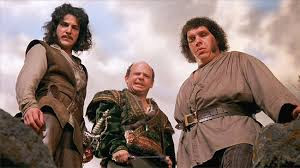 Andre as Fezzik the giant in The Princess Bride.
Andre as Fezzik the giant in The Princess Bride.Andre the Giant was born Andre Rene Roussumoff on May 19, 1946 in France. He dropped out of school in the eighth grade thinking an education was unnecessary for a farm laborer. At seventeen, Andre trained for a wrestling career at night and worked as a furniture mover during the day to pay the bills. Wrestling promoters were quick to realize Andre's money-making potential because of his great size.
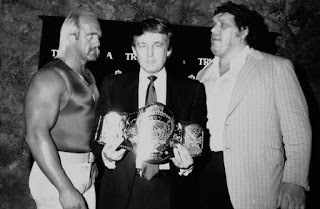 The Giant, The Hulk, and Trump.Andre the Giant was billed as The Eighth Wonder of the World through much of his career. His World Wrestling Federation tenure came to a crashing end during Wrestle Mania III in 1987 when Hulk Hogan gave Andre a body slam followed by the Hulk's running leg drop finisher. Andre's immense weight resulted in his chronic bone and joint pain. On that night at Silverdome Stadium in Pontiac, Michigan, Andre the Giant passed the torch to Hulk Hogan. In the 1980s, Andre branched out and co-starred in several films, most notably the giant Fezzik in The Princess Bride.
The Giant, The Hulk, and Trump.Andre the Giant was billed as The Eighth Wonder of the World through much of his career. His World Wrestling Federation tenure came to a crashing end during Wrestle Mania III in 1987 when Hulk Hogan gave Andre a body slam followed by the Hulk's running leg drop finisher. Andre's immense weight resulted in his chronic bone and joint pain. On that night at Silverdome Stadium in Pontiac, Michigan, Andre the Giant passed the torch to Hulk Hogan. In the 1980s, Andre branched out and co-starred in several films, most notably the giant Fezzik in The Princess Bride.When Andre was wrestling in Detroit, he hung out at the Lindell AC sports bar. Over the years, people have written about Andre's gargantuan appetite for food and drink. Mel Butsicaris recalls one night when Andre came in after a wresting match at 12:45 am.
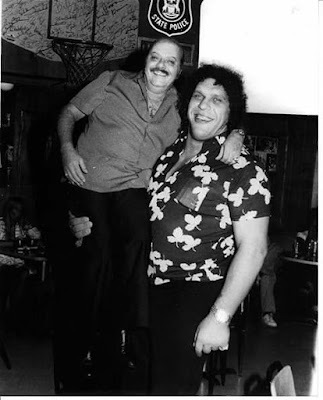 "Many people ask me if I ever met Andre the Giant. Yes. He wasn't just tall. There is a photograph of Andre holding up my Uncle Jimmy with one arm. Look at the difference between a normal person's head and the size of Andre's head. He kept a minivan at the bar with the front seats taken out. He drove from the back seat.
"Many people ask me if I ever met Andre the Giant. Yes. He wasn't just tall. There is a photograph of Andre holding up my Uncle Jimmy with one arm. Look at the difference between a normal person's head and the size of Andre's head. He kept a minivan at the bar with the front seats taken out. He drove from the back seat."You would not believe how much he could eat and drink. I remember one night when Andre ordered a cheeseburger with fries and two beers. We reminded him we were going out to dinner as soon as we closed the bar. Then, he ordered another and another.... In less than an hour and a half, Andre ordered nine cheese burgers with fries and two beers each. Our burgers were 1/3 of a pound of ground round. That's three pounds of meat, not to mention potatoes, bread, and eighteen beers.
"Then we went to the Grecian Gardens restaurant in Greektown. Uncle Jimmy ask the chef to make Andre a special plate of food. They took a serving platter and filled it with a whole chicken, a couple of lamb shanks, pastichio, stuffed grape leaves, rice, vegetables, and all the Greek trimmings. Enough food to feed a family of four. Andre ate it all. We jokingly asked him if he wanted dessert. He replied, 'Not yet, I'll have another one of these,' pointing to his empty platter. I don't remember what he had for dessert."
 Andre's huge size was the result of gigantism caused by excessive growth hormone. The condition is known as acromegaly. It causes pronounced cheekbones, forehead bulges, enlarged jaw protrusion, enlargement of hands, feed, and nose. Internally, it causes a weakening of the heart muscle.
Andre's huge size was the result of gigantism caused by excessive growth hormone. The condition is known as acromegaly. It causes pronounced cheekbones, forehead bulges, enlarged jaw protrusion, enlargement of hands, feed, and nose. Internally, it causes a weakening of the heart muscle.Andre Roussimoff died on January 27, 1993 from congestive heart failure in a Paris hotel room at the age of forty-six. He was in Paris to attend his father's funeral and celebrate his mother's birthday. Andre's body was shipped to the United States for cremation. His ashes were scattered on his ranch in Ellerbe, North Carolina. Andre is survived by one daughter, Robin Christensen Roussimoff born in 1979.
Billy Martin's Detroit Fight Night:
http://fornology.blogspot.com/2017/04/billy-martin-fight-night-in-detroit.html
October 19, 2024
Remembering Detroit's Qwikee Donut and Coffee Shops
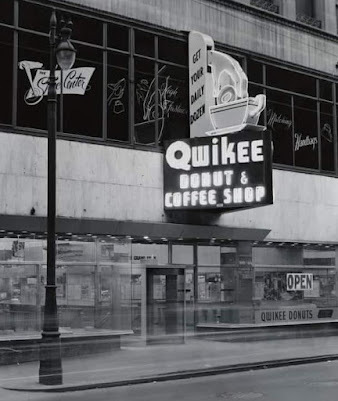
A young, optimistic Russian blacksmith named John Weise migrated to Detroit in the late 1920s, just in time for the Great Depression. Its stranglehold on manufacturing hit the automotive blue collar workforce particularly hard. Nobody was hiring blacksmiths.
Weise struggled but found work where and when he could, learning English as he went along. By 1938, Weise decided to take a risk and go into business for himself. He borrowed some money, bought some equipment, and went into the doughnut and coffee shop business which would eventually make him a wealthy man.
Weise named his new business The New Era as an optimistic gesture for shaking off the bad luck he had experienced in America during his first decade here. His first retail shop was on Bates St. at Cadillac Square. Because of the war in Europe, Detroit factories and businesses were once again bustling with activity. His foresight paid off. The shop was packed from its opening day with customers lining up outside for a quick and inexpensive breakfast.
In 1942, Weise partnered up with Frank Reed and together they opened a second, larger operation in the lobby of the Hammond Building. Both of the shops were branded as Qwikee Donut and Coffee Shop. The new name with its quirky spelling was an effective marketing detail emphasizing their speed and convenience. Their trademark name on their bright, neon signage lit up even the grayest, bone-chilling Detroit mornings.
High-rise office workers soon discovered they could pop in and out in minutes for hot coffee and warm donuts. Downtown shoppers found a convenient place in the shopping loop to take a break and grab a quick bite with some fresh brewed coffee. Qwikee hot chocolate with whipped cream was a favorite with kids in the winter.
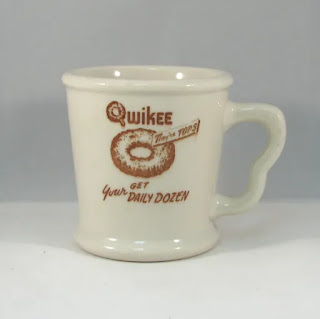 "Get Your Daily Dozen" was their slogan.
"Get Your Daily Dozen" was their slogan.Space was limited in the early shops and restaurant seating took up too much space. The pace of life downtown quickened when the United States entered World War Two. Frank Reed had the idea to install stand-up counters along the walls for their busy customers. Daily editions of the Detroit News, the Free Press, and the Times were enclosed behind glass cases mounted across the walls for the convenience of customers who preferred to stand, slam down a quick cup of coffee and a doughnut, read the headlines, and dash off to work. Reed's second location served 5,000 to 6,000 customers daily.
With the demolition of the Hammond Building in 1956, Weise and Reed opened another larger shop on Grand River Boulevard at State Street. Soon other shops opened. There was one at 222 W. Congress St., one in the Guardian Building, one in the Fisher Building, and the largest shop at State and Griswold St. At that location, sandwiches and warm lunch plates were dispensed with self-service automat machines. Hot dishes with gravy like meatloaf, roasted chicken, and roast beef were popular menu items.
Qwikee Donut expanded their menu to include sandwiches and soups and adopted a cafeteria-style format. At the height of their popularity, Qwikee Donuts numbered five or six locations in the downtown loop serving 20,000 dozen donuts a week. The Grand River Avenue location became a hangout for generations of Cass Tech and other students looking for a warm, dry, convenient place to wait for the bus home which might take over an hour. Since it was after the lunch rush, the owners welcomed their steady business. Better to have customers than an empty shop.
The local doughnut chain became famous for their large, warm, and delicious donuts. You could get them plain, powder-sugared, cinnamon-sugared, iced with chocolate, vanilla, cherry, or orange frosting. Others were glazed and dipped in chopped nuts. They also served jelly and custard-filled doughnuts. Custard-filled were only served in the winter because the summer heat was too dangerous. The filling might spoil and make people sick.
Qwikee Donuts also served sandwiches and soups. Bean and pea soups were popular in the winter, and lighter soups like French onion were served in the summer. Chicken noodle and chili were year-round favorites. All soups were served in crockery bowls. Food was served on plates, and the utensils were stainless steel--never plastic. Sandwiches were traditional and served on sliced white or whole wheat bread from the nearby Wonder Bread bakery. Peanut butter & jelly, egg or tuna salad, and ham, turkey or roast beef with cheese were the standard sandwiches.
Weise and Reed together may have helped revolutionize the fast food business. Their most notable neon marquee sign was mechanical and one of the top three greatest signs in Detroit behind the Vernor's Sign on Woodward and the red and yellow neon, pulsating Flame Show Bar entrance in Paradise Valley. The Qwikee Donut sign had a hand dunking a doughnut into a simulated, steaming cup of coffee, all outlined in neon. That doughnut went up and down all day and never got soggy! The bright sign, co-mingled with the smell of warm doughnuts and freshly brewed coffee, was irresistible.
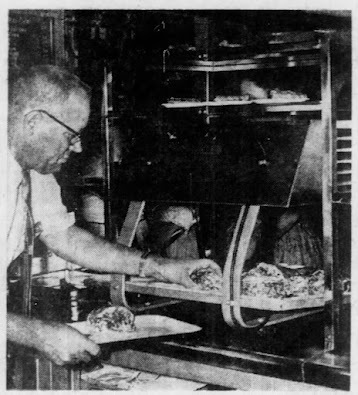 Original Quikee Donut owner John Weise.
Original Quikee Donut owner John Weise.When the Detroit Free Press interviewed John Weise in 1959, he said, "An office boy or girl can come into (our shops) and pick up a dozen cups of coffee and a bag of doughnuts for the entire office staff and be back (to work) before the boss (realizes they are gone)."
John Weise and his partner Frank Reed parlayed their original shops into a million-dollar enterprise that became part of the fabric of downtown Detroit's daily life for decades. When Frank Reed suffered his first heart attack in 1956, he sold his interests in the company to his partner Weise.
Sometime in the 1960s, Weise sold his interest in Quikee Donuts to Joe Hermann and Sons who were in the baking business. Thereafter, he retired. With the decline of downtown business activity in the seventies and eighties, and the loss of downtown shoppers to suburban shopping centers, Qwikee Donuts went quietly out of business in the mid-1980s.
John Weise died at the age of fifty-three on Monday, October 3, 1966, leaving behind his wife Gilda, his sister, three daughters, and three grandchildren. Mr. Weise is buried in White Chapel Memorial Park Cemetery in Troy, Michigan.
Frank Reed suffered a heart attack aboard the ocean liner Queen Elizabeth II en route to Great Britain to begin a European tour. Mr. Reed died August 16, 1979 at the age of seventy-seven leaving behind his wife Hazelle, two brothers, and a sister. He is buried in Palm Beach, Florida.
August 30, 2024
Labor strife--Walter P. Reuther Assassination Attempt Foiled
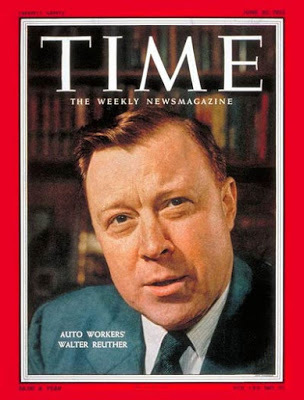
Walter P. Reuther, recently re-elected to a second term as United Automobile Workers (UAW) president, lived with his wife May and their two small daughters in a modest ranch house on Appoline Street in Detroit, just south of Eight Mile Road.
In his 2013 book Built in Detroit: A Story of the UAW, a Company, and a Gangster, Bob Morris recounts the evening of April 20, 1948. After coming home late from a UAW meeting, Reuther prepared to eat his warmed-over dinner. He was opening the refrigerator door to get some peaches when he turned to answer a question from his wife and survived a 12 gauge shotgun blast through the kitchen window.
Four lead pellets lodged in his right arm, one in his chest, and the rest hit the kitchen cabinets. Reuther was taken to New Grace Hospital where doctors told him he might lose his arm. The labor leader was determined to save it. By working tirelessly at painful physical therapy, he was able to regain limited use of his arm. For the rest of his life, neither Reuther nor his family were without UAW bodyguards and traveled everywhere in an armored Packard.
The attempt on Reuther's life was not an isolated incident of industrial violence. Thirteen months later, Walter's brother Victor, met a similar fate. Bob Morris writes, "Late on the evening of May 24, Victor was reading in his living room when a shot gun blast blew threw his front living room window. The shotgun pellets ripped through the right side of his face and upper body tearing out his right eye."
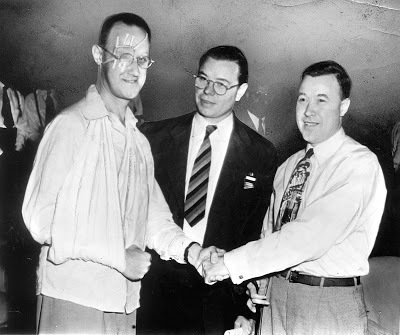 Victor and Walter Reuther shaking hands left-handed with brother Roy between them.
Victor and Walter Reuther shaking hands left-handed with brother Roy between them.At first the Detroit police dismissed the botched murder attempt of Walter Reuther as a power struggle among union Communists. The Red Scare was a popular and convenient scapegoat for corporate America and made good copy for the post-war press. A Detroit detective said, "Gamblers and crime syndicates have nothing to do with this. It's Communists."
But investigators began hearing underworld connections might be involved. Within five days of Reuther being shot, Detroit police--acting on a telephone tip--brought former vice-president of Ford UAW Local 400, Carl E. Bolton, in for questioning. He was charged with intent to commit murder.
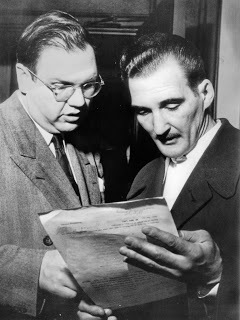 Joseph W. Louisell and Carl. E. BoltonJoseph W. Louisell, Detroit attorney known for defending suspected mob figures, argued Bolton had an alibi and was not at the scene of the crime. After three days in jail, Bolton was released and prosecutors dropped the charges. Bolton was free but still under suspicion.
Joseph W. Louisell and Carl. E. BoltonJoseph W. Louisell, Detroit attorney known for defending suspected mob figures, argued Bolton had an alibi and was not at the scene of the crime. After three days in jail, Bolton was released and prosecutors dropped the charges. Bolton was free but still under suspicion.During the Senator Kefauver Organized Crime Committee hearings (1951-1952), testimony suggested Walter Reuther ran afoul of the Detroit underworld.
Before the shooting, Reuther was aware a Sicilian gang, led by Santo Perrone, was acting as a strike-breaking agency for Detroit companies--big and small. Author Nelson Lichtenstein writes in The Most Dangerous Man In Detroit: Walter Reuther and the Fate of American Labor, "Reuther's assailants were paid by Santo 'the Shark' Perrone, an illiterate but powerful Sicilian gangster." The mid-century labor movement was the age of "the cash payoff, the sweetheart contract, and the gangland beating. It was part of the industrial relations system."
The Organized Crime Committee felt the Detroit police made no serious attempt to solve the crime or curb the anti-union violence. "The Detroit police saw industrial violence as little more significant than a bar brawl," Lichtenstein wrote.
Six years later, Wayne County Prosecutor O'Brien announced at a Detroit press conference that he had solved the Reuther shooting. Arrest warrants were issued for Santo Perrone, Carl B. Renda, Peter M. Lombardo, and Clarence Jacobs.
Donald Ritchie, an ex-con with connections with the Perrones, made a secret arrangement with UAW officials. Ritchie agreed to rat out the people involved with the Reuther shooting for a $25,000 payoff placed in escrow.
If he cooperated with authorities, he would get $5,000 after making the initial statement to the prosecutor and the arrest warrants were issued, an additional $10,000 payable when those named in the warrants were bound over for trial, and another $10,000 when convicted. If murdered before he could cash-in, Ritchie wanted the reward given to his common-law wife.
Part of Ritchie's statement to Prosecutor O'Brien reads, "The night of the shooting, I was picked up at a gas station. The car was a red Mercury.... I sat in the back seat. Clarence Jacobs drove and Peter Lombardo sat in the front seat with Jacobs. The shotgun was in the front seat between (them)--a Winchester 12 gauge pump. I was there in case there was any trouble. If anything happened, I was to drive the car away.
"Jacobs did the shooting. He was the only one who got out of the car.... I heard the report from the gun. Then Jacob got back in the car and said, 'Well, I knocked the bastard down.' After the job, they dropped me off at Helen's bar.... I had some drinks and went to see Carl Renda. He got a bundle of cash and handed it to me. I took a taxi to Windsor and counted my money after I got to Canada. Exactly five grand."
As prearranged, when Ritchie came back across the international border, he was immediately placed under the protection of the Detroit Police Department. While waiting for the trial so he could give his star-witness testimony, he told the Detroit police detail assigned to protect him that he wanted to take a shower. Ritchie escaped from a bathroom window at the Statler Hilton Hotel on Grand Circus Park. Ritchie was on the lam. Once again, he took a cab to safety across the United States/Canada border.
At the same time, Ritchie's common law wife was given the first installment of the escrow account. Ritchie delivered on the first part of the bargain. He made an initial statement and the suspects were charged. The UAW had no choice but pay off the first escrow installment. Ritchie dropped a dime from Canada and denied his entire confession to a Detroit Free Press reporter. He said he needed the money and was taking the UAW for a ride.
Without Ritchie's testimony, Prosecutor O'Brien's case collapsed leaving him with an embarrassing fiasco. He dropped all the charges. The UAW made the stupid mistake of paying a witness. The labor organization had been swindled out of $5,000 by an ex-con.
***
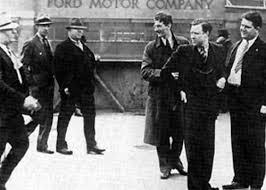 Seconds before the confrontation.The assassination attempt was not the first time Walter Reuther ran afoul of the car companies. On May 26, 1937, Reuther and several other labor organizers were badly beaten by Ford Motor Company Security men in what history notes as the Battle of the Overpass. This was Ford's security chief Harry Bennett's opening salvo against labor organization inside the Ford empire.
Seconds before the confrontation.The assassination attempt was not the first time Walter Reuther ran afoul of the car companies. On May 26, 1937, Reuther and several other labor organizers were badly beaten by Ford Motor Company Security men in what history notes as the Battle of the Overpass. This was Ford's security chief Harry Bennett's opening salvo against labor organization inside the Ford empire. Bob Morris writes, "This was a public relations disaster for Ford, as a Detroit News photographer captured the beating of the labor leaders. The photos... were published around the world. The attack on Walter Reuther made him one of the most recognized labor leaders in Detroit and the country."
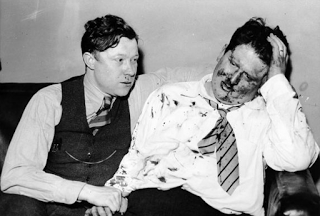 Walter Reuther and Richard Frankensteen
Walter Reuther and Richard Frankensteen Arnold Freeman of the Detroit Times reported that Bennett assembled semi-permanent gangs of thugs known as outside squads. A member of one of those squads "Fats Perry" turned state's evidence in 1939. He testified,
"These squads were armed with pistols, whips, blackjacks, lengths of rubber hose called persuaders, and a variety of weapons, some of which made up by a department in the (Rouge) plant itself."
***
On May11, 1970, The New York Times reported Walter Reuther, his wife May, and four other people died in the crash of a two-engined Lear Jet on May 9th at 9:33 PM. The chartered jet--on its final approach to the Pellston Regional Airport, arriving from Detroit in the fog and rain--broke through the clouds short of the runway and clipped some tree tops sheering off both wings. The plane crashed and burst into a fireball a mile southwest of the airport.
The Federal Aviation Administration listed a faulty altimeter as the official cause. It had been tampered with. Some parts were missing, others were incorrect, and one was installed upside down. No charges were ever filed, but the persistent belief is the crash was not an accident. Reuther was sixty-two.
Silent clip of police investigating Walter Reuther's home after the assassination attempt. His wife speaks briefly to the press. Fingerprints are taken outside the Reuther home.
https://www.youtube.com/watch?v=ZMayuqfDpuI
August 24, 2024
Something Fishy About "The Spirit of Detroit"
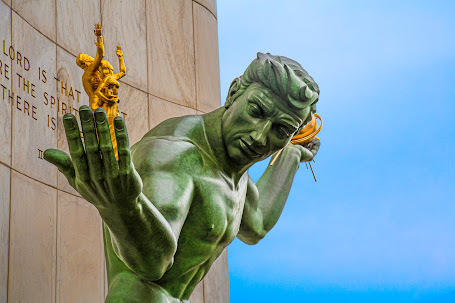 Photo courtesy of Chris Ahern Photography LLC
Photo courtesy of Chris Ahern Photography LLCThe Spirit of Detroit statue has graced the site of the Coleman A. Young Municipal Center (originally known as the City-County Building) on the corner of Woodward and Jefferson Avenues since its installation on September 21, 1958. The Detroit-Wayne Joint Building Authority commissioned the public art as a salute to the new City-County Building on August 2, 1955 with the expressed goal of representing "hope, progress, and the spirit of man."
Royal Oak, Michigan sculptor Marshall Fredericks was chosen to design the statue in keeping with the Building Authority's vision statement. Fredericks waived his artist's commission believing the project was part of his civic responsibility. A plaque in front of the sculpture reads, "The artist expresses the concept that God, through the spirit of man, is manifest in the family, the noblest human relationship." Though the statue was unnamed by its creator, it became popularly known as The Spirit of Detroit becoming the ubiquitous symbol representing the City of Detroit.
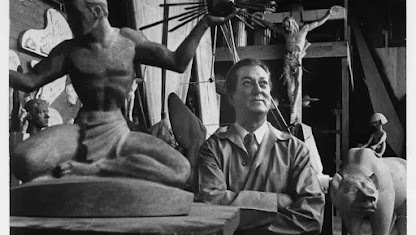 Spirit of Detroit model and sculptor Marshall Fredericks.
Spirit of Detroit model and sculptor Marshall Fredericks.After the design concept was sculpted in clay and agreed upon by the Building Authority, Fredericks cast the model in plaster at one-quarter scale of what the final product would become. Under his supervision, the scale model was shipped to Oslo, Norway to a foundry large enough to cast the statue in bronze. The model was scaled up to 26 feet tall. This statue soon became known as the largest bronze statue cast since the Renaissance.
The focal point of the statue is a supernatural-sized, seated figure covered in a rich green patina. In his left hand, this colossus holds a gilded sphere emanating golden rays lighting the heavens symbolizing God. In his right hand, the figure holds a gilded family of four symbolizing human relationships. The theme reflects mid-twentieth century views commonly held at the time of the statue's creation.
The massive, nine-ton statue was designed to be installed on a marble base with a curved marble background wall thirty-six feet wide by forty-five feet high, weighing in at a combined sixty tons. The wall contains the seal of the City of Detroit and the seal of Wayne County that Fredericks designed especially for the wall because none had previously existed. Beneath the government seals, the wall contains a New Testament inscription.
"NOW THE LORD IS THAT SPIRIT
AND WHERE THE SPIRIT OF THE LORD IS,
THERE IS LIBERTY"
--2 Corinthians (3:17)
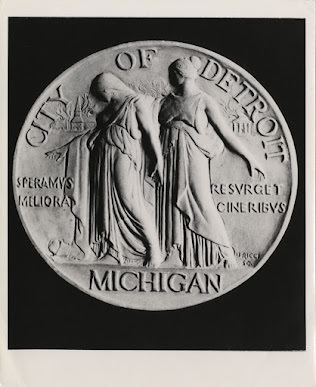 Designed by J.O. Lewis in 1827 representing the devastating fire that destroyed the city in 1805. The Latin inscription reads "We Hope For Better Things--It Will Rise From the Ashes."
Designed by J.O. Lewis in 1827 representing the devastating fire that destroyed the city in 1805. The Latin inscription reads "We Hope For Better Things--It Will Rise From the Ashes."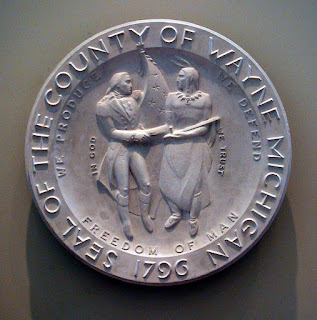 The Wayne County seal was designed especially for the monument by Marshall Fredericks in 1955. The seal commemorates the signing of a peace treaty between Ottawa War Chief Pontiac and American Brigadier General Anthony Wayne.
The Wayne County seal was designed especially for the monument by Marshall Fredericks in 1955. The seal commemorates the signing of a peace treaty between Ottawa War Chief Pontiac and American Brigadier General Anthony Wayne. After the sculpture was cast, it underwent three weeks of heat and cupric nitrate treatments to oxidize the bronze giving it a deep green patina. To ship the statue safely to Detroit, a steel platform was built to load and unload it from the cargo hold of the German freighter Thomas Schulte. The freighter was chartered to make the 4,800 mile sea voyage across the Atlantic Ocean and up the Saint Lawrence Seaway to the Port of Detroit.
Before shipment, every surface of the giant bronze statue was wrapped in layers of burlap cloth for protection. The statue was positioned face and knees down onto a custom built, steel platform and a wooden framework to prevent the statue from shifting during transport. The freighter was also shipping a cache of Mercedes-Benz cars, commercial building materials, and crated food products in its cargo hold.
The Thomas Schulte arrived several days later than scheduled at the Detroit Harbor Terminal on Sunday, September 20, 1958 at 6:55 am. Stevedores on the ship and workers from Dearborn Machinery Movers on the dock were prepared to lift the steel platform from the freighter's cargo hold. To witness the unloading, Fredericks, his wife, a couple of newspapermen, and a Detroit policeman waited anxiously.
But there was an unexpected problem. Ed Galli, president of Dearborn Machinery Movers, referred to The Spirit of Detroit in the Detroit Free Press as "that stinking statue" and for good reason. Galli had volunteered his company's services as a civic gesture. The job was supposed to take six hours and was costing him double time because the freighter was a few days late from its estimated date of arrival, so his union workers were making overtime on a Sunday.
The statue was supposed to be unencumbered in the hold for a simple lift with a crane onto a flatbed trailer, a short trip to the County Building job site, and installation onto the statue's pedestal. Somewhere along the journey, the Mercedes-Benz cars and commercial building supplies were off-loaded leaving four tons of sardines and pickled herring behind in the cargo hold which tumbled onto the statue. Enough of the containers sprung leaks to thoroughly drench the statue's burlap wrapping in a "gooey, odoriferous sardine oil."
First, Galli's men had to help rearrange the ship's cargo hold and rinse off the "little fishy" residue before the statue could be lifted safely onto the flatbed trailer which took a few extra hours. Rather than the installation finishing at noon as scheduled, the job was completed around 7:30 pm. The cost overrun was $5,000, more than Galli had bargained for. It is believed that Marshall Fredericks made good on the unexpected, added expense. The official unveiling and dedication of the statue took place as scheduled three days later on Wednesday, September 23, 1958.
July 5, 2024
The Long-Awaited Ambassador Bridge Connects Detroit with Windsor
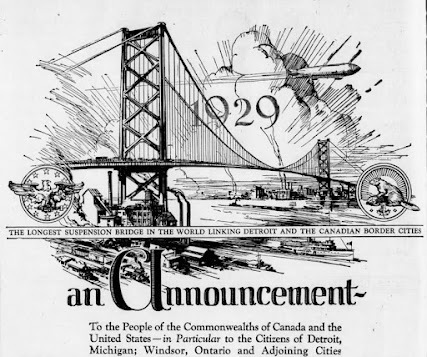 Ambassador Bridge Announcement--Detroit Free Press
Ambassador Bridge Announcement--Detroit Free PressWhen the automobile business took off early in the twentieth century, the need for an international bridge connecting Detroit with Windsor to expand the auto industry and increase international commerce became apparent, but securing government funding for the bridge project was a hard sell fraught with political red tape and delay. The highest-profile person supporting the bridge project was automobile magnate Henry Ford. "The only way to get things done today is by private business," Ford said.
A team of Detroit business leaders incorporated the Detroit Bridge Company and sought out a former Detroiter, successful New York City banker Joseph A. Bower. Bower sold securities to finance the project and was able to raise $23.5 million in privately financed funds, including his own investment.
The project details were presented to the Detroit Common Council and approved unanimously. But one dissenting voice vetoed the project, Mayor John W. Smith. In additional to several ambiguities in the project's prospectus, including revenue for the city of Detroit, Smith was rightly concerned that the bridge deck would only be 135' above the Detroit River.
Mayor Smith, mindful of the future, realized that 135' would limit future navigation of larger freighters. The project engineers went back to the drafting table and re-engineered the bridge to be 152' above the water.
Recognizing the long-term value of the bridge and the threat any further delays might pose to the overall project and his substantial investment, Bower assumed the $50,000 cost of a referendum in a special election supporting bridge construction. The referendum passed by an eight to one margin on June 28, 1927. The next month, McClintic-Marshall engineering firm was awarded the bridge contact which ran from August 16, 1927 until August 16, 1930.
The penalty for late completion would require the firm to pay the interest on the securities until the bridge could generate revenue. If they finished construction early, they would be entitled to half of the bridge's revenue until the official end of the original contract. The newly christened Ambassador Bridge opened six months ahead of schedule despite having to change out the original suspension cables which were found to become brittle in freezing weather. They were quickly replaced with cables spun with stronger cold-roll steel. Still, the bridge cost came in 1% under the original budget allocation.

When finished, the Ambassador Bridge was 1.5 miles long, requiring 21,000 tons of steel. The clearance from the Detroit River was 152' but the bridge's roadway never rises above a gentle 5% grade. The four-lane roadbed (two coming and two going) was 47' wide with an 8' wide pedestrian sidewalk on the west side of the bridge. The bridge was anchored on the American side on West Jefferson and 21st Street. On the Canadian side, the anchorage touched down on London St and Huron Line Road in Sandwich, Ontario.
Opening day ceremonies coincided with Armistice Day (Veteran's Day) Monday, November 11, 1929. An estimated 100,000 from both sides of the Ambassador Bridge were on hand to cheer the ceremonial opening. With much pomp and circumstance, dignitaries from both countries held cermonies on their respective sides of the bridge. At 3:15 pm, Canadian bands played patriotic selections such as "God Save the King" and "Oh Canada," while at the same time, American bands on their side played tunes like "America" and "The National Anthem."
Following the musical programs, speeches were made by dignitaries on both sides of the bridge. Then, bronze "Friendship Tablets" designed by New York sculptor Jonathan M. Swanson were unveiled on the anchorages on both sides of the bridge. The plaques celebrated more than 115 years of friendship between the United States and Canada. The ceremony ended when dignitaries met at the exact international boundry. They shook hands and cut a white, silk ribbon. Then in concord, sirens and fog horns of river craft sounded continuous acclamation while many airplanes soared and circled above the bridge.
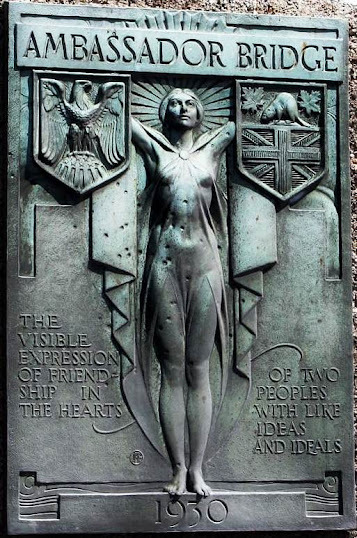 The bridge was originally scheduled to open in 1930 which is what the plaques reflect.
The bridge was originally scheduled to open in 1930 which is what the plaques reflect.In what only can be described as a loosely controlled riot, joyous crowds on both ends of the bridge swarmed the deck. When the roadbed became so crowded that people could not move, some of the braver revellers climbed the construction catwalks on each side of the bridge to the top of the piers. It took well into the night before the bridge was cleared and secured again.
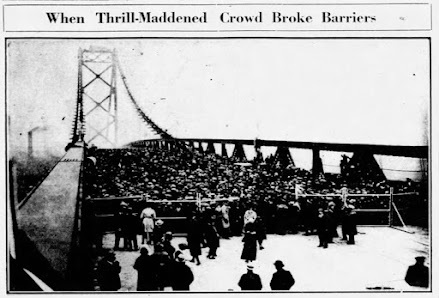 Photo from Windsor Star.
Photo from Windsor Star.Four days later, the Ambassador Bridge opened for business. The opening was signaled by the passage of two cars filled with dignitaries from each country that left simultaneously from each side of the bridge. They honked in friendship as they passed at the center of the bridge and a signal cannon boomed to officially open the bridge to the toll-paying public. Cheers and applause broke out on both ends of the bridge.
The Ambassador Bridge was now officially open. An estimated 235,000 persons crossed the bridge the first day--35,000 of them were pedestrians. Traffic was backed up almost two miles on each bridge approach with people wanting to claim bragging rights that they had crossed on the first day.
On opening day, American customs officials reported that eleven quarts of whiskey were seized in three separate incidents. Prohibition was still in effect on the American side. At 8 pm, a man carrying four quarts, and at 9:15 pm, a woman carrying six quarts were detained by customs inspectors. Both people used the same excuse, they needed the whiskey to make holiday fruit cake." Just after 11 pm, a single quart was found tucked under the back seat of a car.
It was determined by customs agents that none of the instances was a commercial violation. The smuggled Canadian liquor was confiscated and the offenders were released after paying a $5 fine for each quart.
The Ambassador Bridge had the misfortune of opening just twenty-one days before the Great Depression struck. To compound the misery of the bridge's investors, the new Detroit-Windsor Tunnel opened downtown the following year charging lower automobile tolls. One factor remained in the bridge's favor though, the Detroit Bridge Company held a monopoly as the only Michigan international crossing for the commercial truck business.
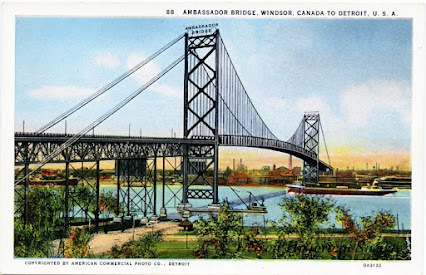
When World War II broke out just over a decade later, American gas rationing dramatically cut automobile bridge traffic, but commercial truck traffic increased due to the war effort. In 1944, two years into the United States entry into the war, the Ambassador Bridge became profitable for the first time. Investors were paid 75 cents per share which began an unbroken stream of dividends every year since.
June 20, 2024
A Brief History of the Gordie Howe International Bridge

With theinstallation of final edge girders on the Gordie Howe International Bridge onJune 14, 2024, the long-awaited connection between the Canadian and UnitedStates sides of the Detroit River transpired.
This momentous occasion was theculmination of a nineteen year journey which began on June 15, 2005, when theMichigan Department of Transportation (MDOT) announced that a new internationalbridge was being proposed by a bi-national partnership between the UnitedStates Federal Highway Commission and Canada’s Ontario Ministry ofTransportation. Its mission was to address “border crossing needs inSoutheastern Michigan and Southwestern Ontario.”
Highwaytraffic research on both sides of the border indicated that the presentAmbassador Bridge, which went into service over ninety years ago in 1929, wasinadequate to meet the region’s future needs. The new bridge project originallyknown as the Detroit River International Crossing (DRIC) would have six lanes withan additional twelve foot wide pedestrian and bike lane, rather than the fourlanes of the current Ambassador Bridge.
Thecable-stayed bridge would have a 138’ clearance from the river and a totallength of 8,202’ (1.5 miles). At its highest point of 722’, the bridge wouldrival the height of Detroit’s Renaissance Center. Two-hundred, sixteen spunsteel cables will support the roadway and bear the traffic weight loads. Thebridge will be illuminated at night with high-powered LED lighting.
The bridgeplazas will have 24 primary inspection lanes and 16 toll booths. The port ofentry and border inspection facilities on the United States side will havededicated exit lanes to connect with Interstate 75, while the Canadian port ofentry’s border inspection facilities and toll collection booths will directlyconnect to Ontario Highway 401.
 Artist's rendering of Gordie Howe Bridge lit up at night.
Artist's rendering of Gordie Howe Bridge lit up at night.Arguments infavor of the DRIC bridge were:
· It would improve global trade betweenthe two countries.
· It would create an estimated 10,000constructions jobs and 3,350 permanent jobs.
· It would ease the daily traffic jamsand border delays on both sides of the Detroit River.
· It would save fuel, reduce airpollution, and minimize time lost, especially on the Canadian side where semi-truckscould avoid the gauntlet of city traffic lights leading to the AmbassadorBridge.
***
Majoropposition to the DRIC bridge proposal came from the billionaire owner of theAmbassador Bridge, Manuel “Matty” Moroun, who made his fortune in the truckingindustry and from collecting tolls on both ends of the bridge, including owningthe Duty-Free shops.
TheAmbassador Bridge is one of the few international, privately owned toll bridgesin North America. While the Detroit/Windsor Tunnel downtown allowed passengercars and buses through its crossing, the Ambassador Bridge became the only way commercialtruck traffic could cross the Detroit River for almost 100 years, except for slow,obsolete ferry service. Matty Moroun purchased the Ambassador Bridge from theJoseph A. Bower family in 1979 and enjoyed its monopolistic status for over thirtyyears. Now, the DRIC threatened it.
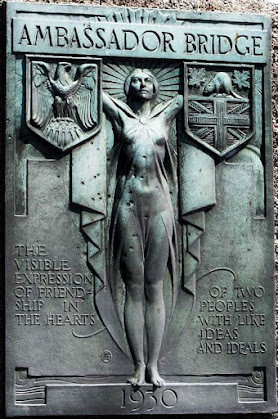 Ambassador Bridge art deco plaque installed midspan.
Ambassador Bridge art deco plaque installed midspan.Moroun usedevery legal delay his lawyers could devise and argued in the courts that hisbridge had “exclusivity rights” granted to him by the previous owners. Thecourts summarily shut down that argument. In desperation, Moroun offered tobuild a six-lane twin span and use the old Ambassador Bridge for foot trafficand special events saying that his proposed project would be less expensive tobuild. The Canadians argued successfully that Mouron’s project would not solvethe underlying traffic problems in the Windsor metropolitan area.
Moroun switchedfrom the court battles to the political arena after losing a lawsuit brought bythe MDOT in 2009 for his failure to construct new ramps to connect theAmbassador Bridge directly to Interstate 75 in violation of a previously negotiatedcontact. Michigan Republicans began voicing their support for Mouron and oppositionto the DRIC bridge project.
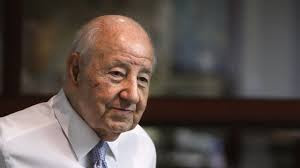 Manuel "Matty" Moroun
Manuel "Matty" MorounIn 2010, Moroun’sopposition to the new bridge prompted the Canadian government to offer to payMichigan’s portion for the new span in exchange for collecting all tolls fromthe bridge for the next fifty years to reimburse Canada. Michigan Senator AlanCropsey, Republican from DeWitt County, remained opposed to the Canadian offer.“The new bridge is unnecessary, and it would put an American businessman(Moroun) out of business. Is this some kind of foreign aid?”
Dan Stampler,president of Moroun’s Detroit International Bridge Company, warned that jobscreated for the DRIC would go to Canadians casting doubt on Michigan’s GovernorJennifer Granholm’s loyalty as a Canadian born United States citizen forsupporting the Canadian funding proposal. “She has offered to sell the Michiganborder to Canada,” Stampler said.
GovernorGranholm quickly refuted the broadside charge as “Totally absurd! When it comesto jobs and expansion on both sides of the border, this is the only game intown.” The political battle raged on.
In 2011, theMichigan Senate rejected a bill that would have allowed the state to accept a$550 million cash advance to fund the United States portion of the bridgeconstruction. United States special interest politics interfered with thebill’s passage. The new Michigan Republican Governor Rick Snyder threw hissupport behind the DRIC bridge bill in his State of the State address tellinghis party that economic growth was his top priority. “It is time to solveproblems,” he said.
In a last-ditcheffort to enforce his will, Moroun promoted a proposal for an amendment to theMichigan Constitution requiring approval for the new bridge construction by notonly Detroit voters, but also Michigan voters at large in statewide elections.The ballot proposal was defeated by a wide 60% to 40% margin. Mouron’saggressive lobbying and litigating had worn thin with Michigan voters pavingthe way for the project to proceed.
***
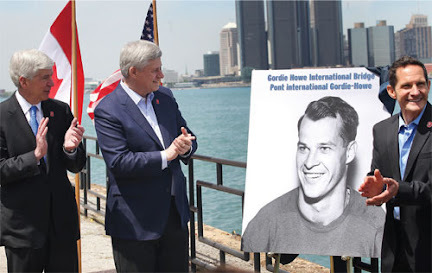
On May 14,2015 in a ceremony along the Detroit River on the Canadian side, MichiganGovernor Rick Snyder, Canadian Prime Minister Stephen Harper, and Gordie Howe’sson Murray Howe jointly announced that the publicly owned DRIC bridge would berenamed the Gordie Howe International Bridge, after a native Canadian whoplayed hockey for the Detroit Red Wings leading them to four Stanley Cupvictories. Because of his prowess on the ice, Howe earned the nickname “Mr.Hockey.” In his remarks at the naming ceremony, Prime Minister Harper said, “GordieHowe was a proud Canadian who built extraordinary goodwill between the twocountries.”
On October26, 2014, Howe had a stroke while at his daughter’s home. At the time of the naming ceremony announcement, Gordie Howe suffered from dementia and could not attend. His son told him about the honor bestowed upon him. Howe said, “Thatsounds pretty good to me.” Thirteen months later on June 19, 2016, he died athis son’s home in Sylvania, Ohio of undisclosed causes at the age of eighty-eight,two years before groundbreaking on the bridge began.
Howe’scasket was brought to the Joe Louis Arena for public visitation. The followingday, his funeral was held at Detroit’s Cathedral of the Most Blessed Sacrament.Acting as pallbearers were hockey great Wayne Gretsky, winningest NHL coachScotty Bowman, and Detroit Tiger legend Al Kaline. Howe’s remains were returned toCanada and interred in Saskatoon, Saskatchewan.
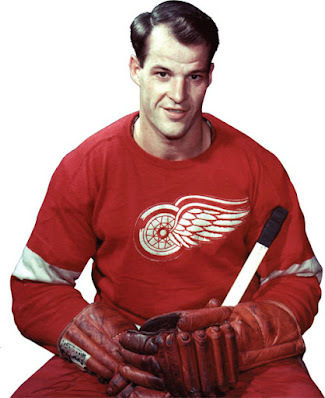 Mr. Hockey--Gordie Howe
Mr. Hockey--Gordie Howe***
Constructionofficially began on the Gordie Howe International Bridge in 2018, but the completionand opening have been delayed due to the COVID-19 pandemic in 2020. The long-awaitedbridge opening is now scheduled for the fall of 2025 once the bridge plazas,signage, and traffic lights are installed. People on both sides of the DetroitRiver look forward with anticipation to the ribbon cutting ceremony marking theend of a twenty year odyssey.
May 26, 2024
Detroit's Speedboat Champion Gar Wood
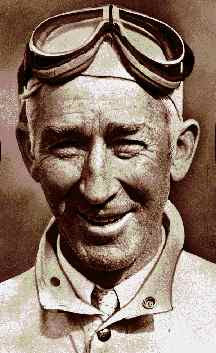 Garfield "Gar" WoodOne of the least remembered Detroit sports celebrities is speedboat champion Garfield "Gar" Authur Wood. He was known as the "Grey Fox of Algonac" by many in the speedboat racing world. He was the first person to go over 100 mph on the water. Gar Wood won five straight powerboat Gold Cup races between 1917 and 1921. He won the British International Trophy for Motorboats known as the Harmsworth Trophy nine times and retired from speedboat racing in 1933 to concentrate on business concerns.
Garfield "Gar" WoodOne of the least remembered Detroit sports celebrities is speedboat champion Garfield "Gar" Authur Wood. He was known as the "Grey Fox of Algonac" by many in the speedboat racing world. He was the first person to go over 100 mph on the water. Gar Wood won five straight powerboat Gold Cup races between 1917 and 1921. He won the British International Trophy for Motorboats known as the Harmsworth Trophy nine times and retired from speedboat racing in 1933 to concentrate on business concerns.Gar Wood was born in Mapleton, Iowa on December 4, 1880. His father was a patriotic Civil War veteran and named Gar after the current president James A. Garfield and his vice-president Chester Arthur. Gar was the third of twelve children. As a growing boy, Gar assisted his father who was a ferryboat operator on Lake Osakia in Minnesota. It is here where he learned his love of boating and developed his mechanical skill for inventing devices to solve mechanical problems.
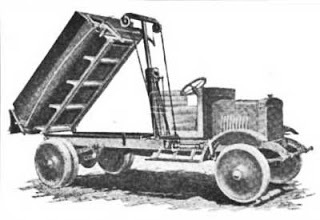 Without any formal engineering training, Gar Wood invented the hydraulic lift for the titling beds of coal trucks in 1911 at the age of thirty-one. In addition to the dump truck, his company developed the self-packing garbage truck familiar in every corner of this country. In all, Gar Wood held over thirty United States patents making him a multi-millionaire by the age of forty.
Without any formal engineering training, Gar Wood invented the hydraulic lift for the titling beds of coal trucks in 1911 at the age of thirty-one. In addition to the dump truck, his company developed the self-packing garbage truck familiar in every corner of this country. In all, Gar Wood held over thirty United States patents making him a multi-millionaire by the age of forty. Gar Wood and his eight brothers established the Wood Hoist Company which soon became Garwood Industries. Alongside industrial giants like Ford, Dodge, and Chalmers, the family built an industrial empire around the hydraulic lift which enabled Gar to pursue his love of speedboat racing.
Gar Wood and his eight brothers established the Wood Hoist Company which soon became Garwood Industries. Alongside industrial giants like Ford, Dodge, and Chalmers, the family built an industrial empire around the hydraulic lift which enabled Gar to pursue his love of speedboat racing.In 1916, Gar Wood purchased his first motorboat naming it Miss Detroit. The following year he put a Curtiss "12" airplane engine in a speedboat against the advice of everyone and won the 15th Annual Gold Cup Race on the Detroit River. Fours years later, he set a new water speed record of 74.87 mph. In the next twelve years, he and his racing team built ten Miss America's and broke the water speed record five more times raising the speed to 124.86 mph on the St. Clair River in 1932.
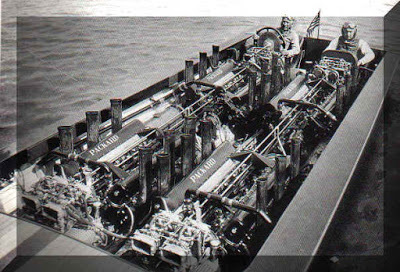
Miss America X was the last of Gar Wood's racing boats. The $600,000 speed boat was powered by four 1800 horsepower, twelve cylinder Packard engines run in tandem in a double-hulled boat. The boat's stringers were made of top quality spruce with the rest of the boat made of mahogany. This was the first boat to go over two miles a minute using 10 gallons of fuel per mile when full open. After Wood won the international Harmsworth Trophy in 1932 and 1933, he retired from racing leaving his son to carry on the family tradition. Gar Wood did more to develop the American speedboat sport than anybody.
In the 1930s, Garwood Industries built a new boat plant in Marysville, Michigan capable of producing 1,200 quality custom boats a year. Their two basic commercial models were a 28' runabout and a 22' runabout. In all, the factory produced 10,000 boats before the company converted over to the war effort during World War II. The company had extensive military contracts for military hoists, hydraulic units, dump trucks, tow trucks, and transport trucks. After the war, Garwood Industries quit boat production in 1947.
In his later years, Wood worked on a commercially feasible, battery-powered electric automobile. His electric car used eight 12-volt lead batteries connected in a series to power two specially designed 90-volt, 2 hp DC motors. The top speed was 52 mph and cost about twenty cents to recharge the batteries. The car was named the Gar Wood Super Electric Model A and was featured in the July 1967 issue of Popular Mechanics.
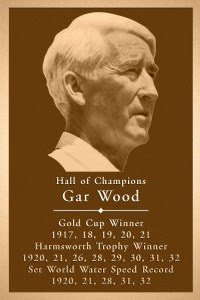 Garfield Arthur Wood died from stomach cancer at the age of ninety on June 19, 1971 and was buried in Algonac, Michigan. Upon his death, Detroit News reporter George Van wrote, "To the public, he was Tom Swift, Jules Verne, and Frank Merriwell, with a little bit of Horatio Alger thrown in."
Garfield Arthur Wood died from stomach cancer at the age of ninety on June 19, 1971 and was buried in Algonac, Michigan. Upon his death, Detroit News reporter George Van wrote, "To the public, he was Tom Swift, Jules Verne, and Frank Merriwell, with a little bit of Horatio Alger thrown in."A short clip of Miss America X and Gar Wood in action winning the Harmsworth Trophy in 1932.
https://www.youtube.com/watch?v=CMlahrYMF74



